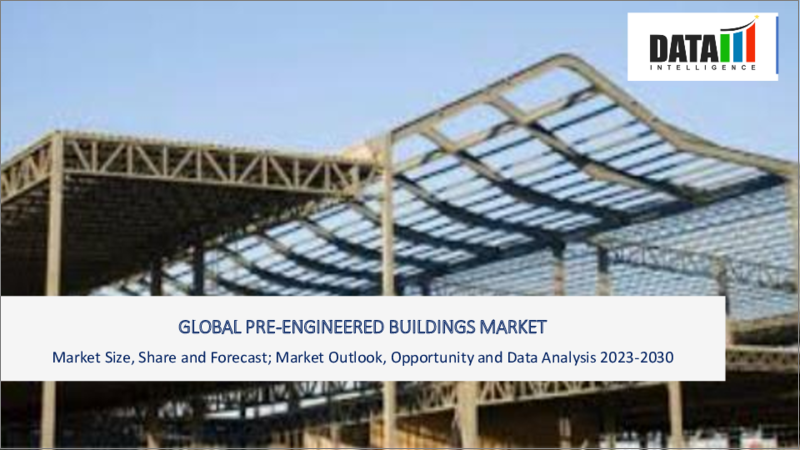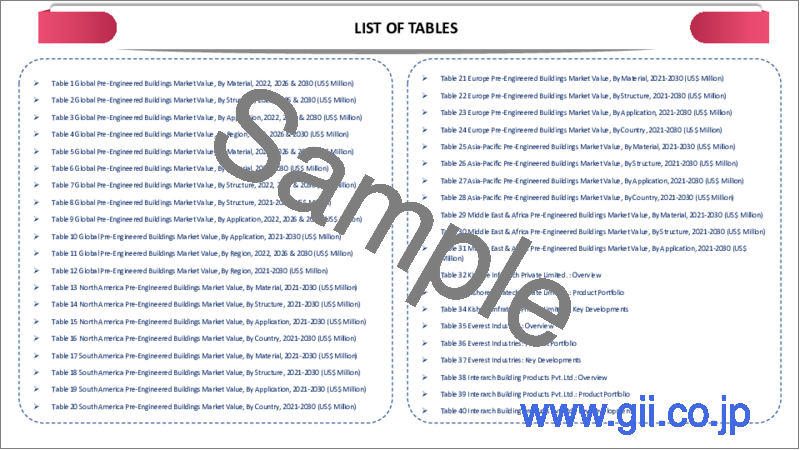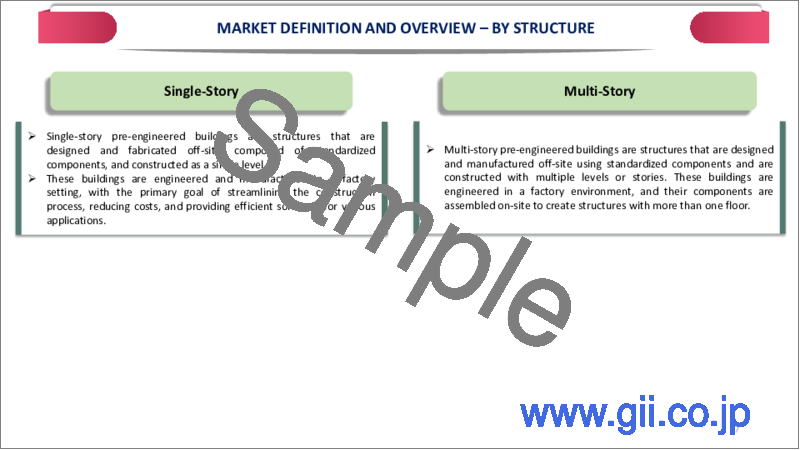|
|
市場調査レポート
商品コード
1290365
プレハブ建築の世界市場-2023-2030Global Pre-Engineered Buildings Market - 2023-2030 |
||||||
|
● お客様のご希望に応じて、既存データの加工や未掲載情報(例:国別セグメント)の追加などの対応が可能です。 詳細はお問い合わせください。 |
|||||||
| プレハブ建築の世界市場-2023-2030 |
|
出版日: 2023年06月12日
発行: DataM Intelligence
ページ情報: 英文 211 Pages
納期: 約2営業日
|
- 全表示
- 概要
- 目次
市場概要
プレハブ建築の世界市場は、2022年に146億米ドルに達し、2023-2030年の予測期間中にCAGR 12.6%で成長し、2030年には379億米ドルに達すると予想されています。
環境の持続可能性に対する意識の高まりが、プレハブ建築市場に影響を与えています。メーカーや建設業者は、持続可能性の目標を達成し、市場の魅力を高めるために、エネルギー効率の高い設計、再生可能エネルギーの統合、環境に優しい建設資材などのグリーンビルディングの実践を取り込んでいます。
アジア太平洋、北米、中東・アフリカなどの地域の政府は、持続可能性とグリーンビルディングの推進に多額の投資を行っており、プレハブ建築市場の将来の成長見通しを向上させています。
世界のプレハブ建築市場は非常に競争が激しく、いくつかの既存企業や地域企業がこの業界で事業を展開しています。一方、新興企業はまだ成長の初期段階にあり、プレハブ建築市場の成長により、予測期間中にシェアを拡大することが予想されます。
市場力学
急成長経済圏におけるインフラ投資の増加
急成長する経済圏におけるインフラ投資の増加は、新規建設プロジェクトの需要を喚起し、プレハブ建築(PEB)市場の活性化に貢献します。経済成長に伴い、人口の増加に対応し、経済活動を支えるために、新しい建物や構造物の必要性が高まっています。構造物には、倉庫、工場、オフィスビル、小売スペース、その他の商業・工業・農業用建物などが含まれます。
PEBは、その費用対効果や効率性から、このような需要に応えるのに適しています。標準化された設計と部品を使ってプレハブで製造されるため、従来の建築方法と比較して、建設期間とコストを削減することができます。また、PEBの使用は、建物の製作と組み立てを工場で行うことができるため、現場での熟練労働者の必要性を減らすことができ、急成長する経済における熟練労働者の不足を解消するのに役立ちます。
新しいインフラへの投資の高まりは、主要プレーヤーが市場に新製品を投入することを後押ししています。例えば、2022年3月23日、PEB Steel Buildings Co.(Pebsteel)は、成長中のプレエンジニアリング鉄骨建築会社で、リフレッシュしたブランドアイデンティティを市場に投入しています。このブランディングは、新しい開発段階において最先端の経済的なソリューションを顧客に提供するというPebsteelの長期目標を補完するものです
サステイナビリティとグリーンビルディングの実践
世界各国の政府は、持続可能な建築手法を促進する規制と政策を実施しています。これらの規制には、エネルギー効率基準、グリーンビルディングコード、持続可能な建設に対するインセンティブが含まれます。プレハブ建築市場は、持続可能な建築の要件に沿ったこうした規制の支援から恩恵を受け、建設プロジェクトにおけるプレハブ建築の採用を促進しています。
LEED(Leadership in Energy and Environmental Design)やBREEAM(Building Research Establishment Environmental Assessment Method)などのグリーンビルディング認証は、世界的に注目されています。これらの認証は、プレハブ建築の利用を含む持続可能な建設手法を認識し、促進するものです。グリーン認証や関連するインセンティブを利用することで、デベロッパー、建築家、建設業者がプレハブ建築を採用し、市場を活性化させることができます。
伝統的な工法別価格競争
在来工法やモジュール工法などの代替工法との価格競争は、プレハブ建築市場に影響を与える可能性があります。競合する工法が同様のコストメリットを提供する場合、または価格競争が激しい場合、市場の成長性に影響を与える可能性があります。
さらに、プレハブ建築は、建設時間や労働力の面で長期的なコスト削減が可能ですが、初期投資額は従来の建築に比べて高く見えるかもしれません。特に、長期的な利益よりも短期的な金銭的配慮に重点を置いている場合、初期費用がかかると、潜在顧客がプレハブ建築を検討する意欲をなくす可能性があります。初期投資額が高いという認識は、伝統的な手法を好む価格競争の一因となる可能性があります。
COVID-19影響分析
パンデミックは、プレハブ建築の原材料や部品の入手を含め、世界なサプライチェーンに混乱をもたらしました。輸送の制限、工場の閉鎖、生産能力の低下により、資材の供給に遅れが生じ、プロジェクトのスケジュールに影響を与え、コストを増加させました。
さらに、パンデミックは世界の景気後退の引き金となり、建設プロジェクトへの投資に影響を及ぼしました。景気の先行きが不透明で、財政的な制約もあることから、建設支出は減少し、潜在的な顧客からのアプローチも慎重になりました。このような不確実性から、パンデミックの初期段階において、プレハブ建築の需要は減少しました。
目次
第1章 調査手法とスコープ
- 調査手法
- 調査目的および調査範囲
第2章 定義と概要
第3章 エグゼクティブサマリー
- 構造別スニペット
- スニペット:用途別
- 地域別スニペット
第4章 市場力学
- 影響要因
- 促進要因
- 急成長する経済圏におけるインフラ投資の増加
- サステナビリティとグリーンビルディングの実践
- 抑制要因
- 従来の建築手法との競合
- 従来の建築手法別価格競争
- 機会
- 影響分析
- 促進要因
第5章 産業分析
- ポーターのファイブフォース分析
- サプライチェーン分析
- 価格分析
- 法規制の分析
第6章 COVID-19の分析
- COVID-19の分析
- COVID前のシナリオ
- COVID中のシナリオ
- COVID後のシナリオ
- COVID-19の中での価格・ダイナミクス
- 需給スペクトル
- パンデミック時の市場に関連する政府の取り組み
- メーカー別戦略的な取り組み
- サマリー
第7章 構造別
- 平屋
- 多層階
第8章 用途別
- 商業・インフラ
- 産業用
第9章 地域別
- 北米
- 米国
- カナダ
- メキシコ
- 欧州
- ドイツ
- 英国
- フランス
- イタリア
- ロシア
- その他欧州
- 南米
- ブラジル
- アルゼンチン
- その他南米地域
- アジア太平洋地域
- 中国
- インド
- 日本
- オーストラリア
- その他アジア太平洋地域
- 中東・アフリカ地域
第10章 競合情勢
- 競合シナリオ
- 市況/シェア分析
- M&A(合併・買収)分析
第11章 企業プロファイル
- Tata BlueScope Steel
- 会社概要
- 製品ポートフォリオと説明
- 財務概要
- Everest Industries
- Interarch Building Products
- Jindal Prefab
- Kirby Building Systems
- Lloyd Insulations
- PEB Steel Buildings
- Tiger Steel Engineering
- Zamil Steel
第12章 付録
Market Overview
Global Pre-Engineered Buildings Market reached US$ 14.6 billion in 2022 and is expected to reach US$ 37.9 billion by 2030 growing with a CAGR of 12.6% during the forecast period 2023-2030.
Increasing awareness of environmental sustainability has influenced the pre-engineered buildings market. Manufacturers and builders are incorporating green building practices, such as energy-efficient designs, renewable energy integration and environmentally friendly construction materials, to meet sustainability goals and enhance the market's appeal.
Governments in regions like Asia-Pacific, North America and Middle East and Africa are investing heavily in promoting sustainability and green building practices thus improving the future growth prospects for the pre-engineered buildings market.
The global pre-engineered buildings market is highly competitive, with several established and regional players operating in the industry. The key players are holding up to 70.4% share in the market whereas startup companies are still at the initial stage of growth and expected to show incremental share in the forecast period due to rising growth of the pre-engineered buildings market.
Market Dynamics
Increasing Infrastructure Investments In Fast-Growing Economies
Increasing infrastructure investments in fast-growing economies can help to boost the pre-engineered buildings (PEB) market by creating demand for new construction projects. As economies grow, there is a greater need for new buildings and structures to accommodate the growing population and support economic activities. The structures include warehouses, factories, office buildings, retail spaces and other commercial, industrial and agricultural buildings.
PEBs are well-suited to meet this demand due to their cost-effectiveness and efficiency. They are prefabricated using standardized designs and parts, which reduces construction time and costs compared to traditional building methods. The use of PEBs can also help to address the shortage of skilled labor in fast-growing economies, as the fabrication and assembly of the building can be done in a factory, reducing the need for skilled labor on site.
The rising investment in new infrastructure has encouraged the key players to launch new products in the market. For instance, On 23 March 2022, PEB Steel Buildings Co., Ltd. (Pebsteel), a growing pre-engineering steel construction company, launches its refreshed brand identity to the market. The branding complements Pebsteel's long-term goal of providing clients with cutting-edge, economical solutions during a new development stage
Sustainability and Green Building Practices
Governments worldwide are implementing regulations and policies that promote sustainable construction practices. These regulations may include energy efficiency standards, green building codes and incentives for sustainable construction. The pre-engineered buildings market benefits from such regulatory support as it aligns with sustainable construction requirements, encouraging the adoption of pre-engineered buildings in construction projects.
Green building certifications, such as LEED (Leadership in Energy and Environmental Design) and BREEAM (Building Research Establishment Environmental Assessment Method), have gained prominence globally. These certifications recognize and promote sustainable construction practices, including the use of pre-engineered buildings. The availability of green certifications and associated incentives encourages developers, architects and builders to adopt pre-engineered buildings, boosting the market.
Price Competition From Traditional Practices
Price competition from alternative construction methods, such as traditional construction or modular construction, can affect the pre-engineered buildings market. If competing construction methods offer similar cost advantages or if there is intense price competition, it may impact the market's growth potential.
Furthermore, pre-engineered buildings offer long-term cost savings in terms of construction time and labor, the initial investment may appear higher compared to traditional construction. The upfront cost can discourage potential customers from considering pre-engineered buildings, especially if they are focused on short-term financial considerations rather than long-term benefits. The perceived higher initial investment can contribute to price competition favoring traditional practices.
COVID-19 Impact Analysis
The pandemic caused disruptions in global supply chains, including the availability of raw materials and components for pre-engineered buildings. Restrictions on transportation, factory closures and reduced production capacity led to delays in the supply of materials, affecting project timelines and increasing costs.
Furthermore, the pandemic triggered an economic downturn globally, impacting investment in construction projects. Uncertainty surrounding the future of the economy and financial constraints led to a decrease in construction spending and a cautious approach from potential customers. The uncertainty resulted in a decline in demand for pre-engineered buildings during the initial phases of the pandemic.
Segment Analysis
The global pre-engineered buildings market is segmented based on structure, application and region.
Rising Demand For Flexible Designs in Single-Storey Buildings
Single-Storey holds half of the share in the global pre-engineered buildings market. The combination of versatility, speed of construction, design flexibility, structural integrity and sustainability features makes single-story pre-engineered buildings a compelling choice for a wide range of applications. The demand for efficient, economical and flexible single-story structures continues to drive the growth of the global pre-engineered buildings market.
Furthermore, single-story pre-engineered buildings offer cost advantages over multi-story structures. They typically require less material, have simplified foundation requirements and involve shorter construction timelines.
The controlled manufacturing process and the use of standardized components in pre-engineered building systems help streamline production, reduce waste and lower overall construction costs. These cost benefits make single-story pre-engineered buildings an attractive choice for various industries and applications.
Geographical Analysis
Asia-Pacific's Cheap Labor, Trade Liberalization and Favorable Government Construction Policies
The construction industry in Asia-Pacifi is thriving, driven by investments in infrastructure projects, industrial development and commercial construction. The Asia Pacific infrastructure market is projected to grow 7 - 8%% a year over the coming decade, reaching US$5.36 trillion a year by 2025 representing around 60% of the world total.
Countries like China, India, Japan and Australia are experiencing robust construction activities, creating a strong demand for pre-engineered buildings. China, India, U.S. and Indonesia will account for around 58.3% of the estimated global growth in construction between 2020-2030. China alone will account for 26.1% of global growth. India is forecast to account for 14.1% while Indonesia is expected to account for 7.0% of global growth.
The government in the region are investing heavily in adopting sustainable building practice to encourage the growth of green building in the region. Furthermore, the need for efficient and time-sensitive construction solutions and rising awareness of green buildings support the growth of the pre-engineered buildings market in the region.
Competitive Landscape
The major global players include: Tata BlueScope Steel, Era Infra, Everest Industries, Interarch Building Products, Jindal Prefab, Kirby Building Systems, Lloyd Insulations, PEB Steel Buildings, Tiger Steel Engineering and Zamil Steel.
Why Purchase the Report?
- To visualize the global pre-engineered buildings market segmentation based on structure, application and region, as well as understand key commercial assets and players.
- Identify commercial opportunities by analyzing trends and co-development.
- Excel data sheet with numerous data points of pre-engineered buildings market level with all segments.
- PDF report consists of a comprehensive analysis after exhaustive qualitative interviews and an in-depth study.
- Product mapping available as Excel consisting of key products of all the major players.
The Global Pre-engineered Buildings Market Report Would Provide Approximately 53 Tables, 45 Figures and 211 Pages.
Target Audience 2023
- Manufacturers / Buyers
- Industry Investors/Investment Bankers
- Research Professionals
- Emerging Companies
Table of Contents
1. Methodology and Scope
- 1.1. Research Methodology
- 1.2. Research Objective and Scope of the Report
2. Definition and Overview
3. Executive Summary
- 3.1. Snippet by Structure
- 3.2. Snippet by Application
- 3.3. Snippet by Region
4. Dynamics
- 4.1. Impacting Factors
- 4.1.1. Drivers
- 4.1.1.1. Increasing Infrastructure Investments In Fast-Growing Economies
- 4.1.1.2. Sustainability and Green Building Practices
- 4.1.2. Restraints
- 4.1.2.1. Competition From Traditional Construction Practices
- 4.1.2.2. Price Competition From Traditional Practices
- 4.1.3. Opportunity
- 4.1.4. Impact Analysis
- 4.1.1. Drivers
5. Industry Analysis
- 5.1. Porter's Five Force Analysis
- 5.2. Supply Chain Analysis
- 5.3. Pricing Analysis
- 5.4. Regulatory Analysis
6. COVID-19 Analysis
- 6.1. Analysis of COVID-19
- 6.1.1. Scenario Before COVID
- 6.1.2. Scenario During COVID
- 6.1.3. Scenario Post COVID
- 6.2. Pricing Dynamics Amid COVID-19
- 6.3. Demand-Supply Spectrum
- 6.4. Government Initiatives Related to the Market During the Pandemic
- 6.5. Manufacturers' Strategic Initiatives
- 6.6. Conclusion
7. By Structure
- 7.1. Introduction
- 7.1.1. Market Size Analysis and Y-o-Y Growth Analysis (%), By Structure
- 7.1.2. Market Attractiveness Index, By Structure
- 7.2. Single-story*
- 7.2.1. Introduction
- 7.2.1.1. Market Size Analysis and Y-o-Y Growth Analysis (%)
- 7.2.1. Introduction
- 7.3. Multi-Storey
8. By Application
- 8.1. Introduction
- 8.1.1. Market Size Analysis and Y-o-Y Growth Analysis (%), By Application
- 8.1.2. Market Attractiveness Index, By Application
- 8.2. Commercial and Infrastructure*
- 8.2.1. Introduction
- 8.2.1.1. Market Size Analysis and Y-o-Y Growth Analysis (%)
- 8.2.1. Introduction
- 8.3. Industrial
9. By Region
- 9.1. Introduction
- 9.1.1. Market Size Analysis and Y-o-Y Growth Analysis (%), By Region
- 9.1.2. Market Attractiveness Index, By Region
- 9.2. North America
- 9.2.1. Introduction
- 9.2.2. Key Region-Specific Dynamics
- 9.2.3. Market Size Analysis and Y-o-Y Growth Analysis (%), By Structure
- 9.2.4. Market Size Analysis and Y-o-Y Growth Analysis (%), By Application
- 9.2.5. Market Size Analysis and Y-o-Y Growth Analysis (%), By Country
- 9.2.5.1. The U.S.
- 9.2.5.2. Canada
- 9.2.5.3. Mexico
- 9.3. Europe
- 9.3.1. Introduction
- 9.3.2. Key Region-Specific Dynamics
- 9.3.3. Market Size Analysis and Y-o-Y Growth Analysis (%), By Structure
- 9.3.4. Market Size Analysis and Y-o-Y Growth Analysis (%), By Application
- 9.3.5. Market Size Analysis and Y-o-Y Growth Analysis (%), By Country
- 9.3.5.1. Germany
- 9.3.5.2. The UK
- 9.3.5.3. France
- 9.3.5.4. Italy
- 9.3.5.5. Russia
- 9.3.5.6. Rest of Europe
- 9.4. South America
- 9.4.1. Introduction
- 9.4.2. Key Region-Specific Dynamics
- 9.4.3. Market Size Analysis and Y-o-Y Growth Analysis (%), By Structure
- 9.4.4. Market Size Analysis and Y-o-Y Growth Analysis (%), By Application
- 9.4.5. Market Size Analysis and Y-o-Y Growth Analysis (%), By Country
- 9.4.5.1. Brazil
- 9.4.5.2. Argentina
- 9.4.5.3. Rest of South America
- 9.5. Asia-Pacific
- 9.5.1. Introduction
- 9.5.2. Key Region-Specific Dynamics
- 9.5.3. Market Size Analysis and Y-o-Y Growth Analysis (%), By Structure
- 9.5.4. Market Size Analysis and Y-o-Y Growth Analysis (%), By Application
- 9.5.5. Market Size Analysis and Y-o-Y Growth Analysis (%), By Country
- 9.5.5.1. China
- 9.5.5.2. India
- 9.5.5.3. Japan
- 9.5.5.4. Australia
- 9.5.5.5. Rest of Asia-Pacific
- 9.6. Middle East and Africa
- 9.6.1. Introduction
- 9.6.2. Key Region-Specific Dynamics
- 9.6.3. Market Size Analysis and Y-o-Y Growth Analysis (%), By Structure
- 9.6.4. Market Size Analysis and Y-o-Y Growth Analysis (%), By Application
10. Competitive Landscape
- 10.1. Competitive Scenario
- 10.2. Market Positioning/Share Analysis
- 10.3. Mergers and Acquisitions Analysis
11. Company Profiles
- 11.1. Tata BlueScope Steel *
- 11.1.1. Company Overview
- 11.1.2. Product Portfolio and Description
- 11.1.3. Financial Overview
- 11.2. Everest Industries
- 11.3. Interarch Building Products
- 11.4. Jindal Prefab
- 11.5. Kirby Building Systems
- 11.6. Lloyd Insulations
- 11.7. PEB Steel Buildings
- 11.8. Tiger Steel Engineering
- 11.9. Zamil Steel
LIST NOT EXHAUSTIVE
12. Appendix
- 12.1. About Us and Services
- 12.2. Contact Us




